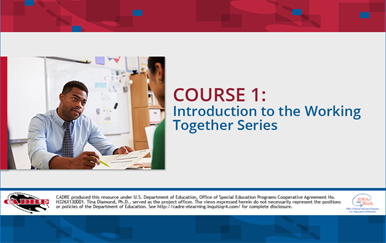In 2011 CADRE’s Director, Marshall Peter (now retired), had the opportunity to interview system managers from each of the four exemplar states. Interviews were conducted with Dee Ann Wilson (Iowa), Patricia Williams (Wisconsin), Kerry Smith (Pennsylvania) and JoAnne Blades (Oklahoma). Questions and their responses can be viewed below by clicking on the images. (double-click videos to view larger image in YouTube)
1. What is the one thing you know now that you wish you had known when you began your job?
2. For almost two years now, you, CADRE and three other states have been exploring the nature of dispute resolution systems. How has that experience affected your thinking?
3. How have you engaged with the Parent Training and Information Centers in your state? What has been the benefit of these efforts?
4. Your state is very committed to stakeholder training. Tell us about your work in that area and the effect that it’s having.
5. Iowa has made a big investment in resolution facilitators. Can you tell us about the AEA Resolution Process and how it is working?
6. Oklahoma makes extensive use of facilitators in resolution meetings. What has been your experience with resolution meeting facilitation?
7. Wisconsin’s stakeholder council is a national model for stakeholder involvement. How has Wisconsin benefitted from active stakeholder participation?
8. Pennsylvania has worked to respond to Part C disagreements within your dispute resolution system. What activities related to Part C outreach and service delivery has been particularly productive?
9. Wisconsin’s Special Education Mediation Services (WSEMS) is a model for bringing together three distinct perspectives. It produces high mediation use and agreement rates. Tell us a bit more about WSEMS and the partnerships it represents.
10. Iowa uses a “Shepherd” to monitor implementation of dispute resolution agreements and fine tune when the parties agree it’s necessary. Tell us a bit more about this function and how it works.
11. Oklahoma made some refinements to your state’s hearing officer compensation system. Can you describe what you did and how that has worked out?
12. Over the last five years, Wisconsin made significant efforts to improve the timeliness of your written state complaint reports. Almost all of them are now completed within 60 days. What do you attribute this to?
13. Your center is located at Oklahoma State University and contracts with the State Education Agency. What do you see as the benefits and challenges of this arrangement?
The Exemplar Collection was developed by CADRE, a project of Direction Service pursuant to Cooperative Agreement CFDA H326D080001 with the Office of Special Education Programs, United States Department of Education. The opinions expressed and materials contained herein do not necessarily reflect the position or policy of the United States Department of Education.


